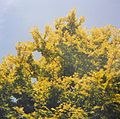Ulmus 'Louis van Houtte'
| Ulmus | |
|---|---|
 'Louis van Houtte' in Christchurch Botanic Gardens, New Zealand | |
| Cultivar | 'Louis van Houtte' |
| Origin | Belgium |
Ulmus 'Louis van Houtte' (Syn. Ulmus 'Vanhouttei') is believed to have been first cultivated in Ghent, Belgium circa 1863.[1][2] It was once thought a cultivar of English Elm Ulmus minor 'Atinia', though this derivation has long been questioned; W. J. Bean called it "an elm of uncertain status".[3] It was first mentioned by Franz Deegen in 1886.[4] Its dissimilarity from the type and its Belgian provenance make the 'Atinia' attribution unlikely. The cultivar is named for the Belgian horticulturist and plant collector Louis Benoit van Houtte, 1810–1876.
Description
When young, the tree has leaves entirely yellow, a colour retained throughout summer. However, as the tree ages, the colouring may begin a gradual reversion to green. The vertically fissured bark of mature trees is unlike that of English elm, with its squarish scaly fissuring. 'Louis van Houtte' has smaller leaves than the not dissimilar Ulmus glabra 'Lutescens' (Golden Wych Elm).
-
'Louis van Houtte' partially reverting, Brighton
-
'Louis van Houtte', Brighton (July 1992)
-
Foliage, botanic garden in Christchurch, New Zealand
-
'Louis van Houtte', Preston Manor, Brighton
-
Leaves, Christchurch, New Zealand
-
Bark, Christchurch, New Zealand
Pests and diseases
'Louis van Houtte' is vulnerable to Dutch elm disease (DED). A specimen at the Ryston Hall arboretum [3], Norfolk, obtained from the Späth nursery in Berlin before 1914,[5] was killed by the earlier strain of DED prevalent in the 1930s, and two specimens planted at Kew Gardens in the Pagoda Vista succumbed very rapidly to the same fate in 1931.[3] A mature specimen, which retained its yellow colouration in the crown, survived in Edinburgh's Royal Circus Gardens, before succumbing to the new strain of DED in the 1990s.[6]
Cultivation
Before Dutch elm disease the tree was commonly cultivated in northern Europe,[7][8] and less commonly in Australasia, where the golden wych elm Ulmus glabra 'Lutescens' has sometimes been mistakenly sold by nurseries under the name 'Louis van Houtte'.[9] Three trees are known in the British Isles.[note 1] The cultivar remains in commerce at a nursery in the USA.
Notable trees
Several large trees survive in Sweden, including an old specimen in Kristianstad.[10] Several old trees survive in Australasia, including a specimen in Christchurch Botanic Gardens, Christchurch, New Zealand.[11]
Synonymy
- 'Ludwig van Houtte': Spath-Buch, 1720–1920, 229, 1921, in error.
- Ulmus montana lutescens van Houttei: Schelle in Beissner et al., Handbuch der Laubholz-Benennung 86. 1903, in error.
- Ulmus minor foliis flavescentibus: Miller, The Gardeners Dictionary ed. 2. 1735, Ulmus no. 8.
Accessions
North America
None known.
Europe
- Brighton & Hove City Council, UK, NCCPG Elm Collection.[12] UK champion: Carden Park, 21 m high, 61 cm d.b.h. (1996).[13]
- National Botanic Gardens [4], Glasnevin, Dublin, Ireland. Location A3 (156)
Australasia
- Christchurch Botanic Gardens, Christchurch, New Zealand. 1 tree, details not known.
- Eastwoodhill Arboretum [5], Gisborne, New Zealand. 2 trees, details not known.
- Manukau Cemetery, Papatoetoe, Auckland, New Zealand. 1 tree.[14]
Nurseries
Europe
- Centrum voor Botanische Verrijking vzw, Kampenhout, Belgium.[15]
North America
- Foothills Nursery [6], Mt. Airy, North Carolina, United States
Australasia
- Southern Woods Plant Nursery [7], Christchurch, New Zealand
Notes
- ^ In Brighton (see Accessions); in Kew's Wakehurst Place collection (hedge form); in the garden of Whitefoord House, Edinburgh (pollarded) (2017).
References
- ^ Boom, B. K. [1] (1959), Nederlandse Dendrologie 1: 158, 1959
- ^ Green, Peter Shaw (1964). "Registration of cultivar names in Ulmus". Arnoldia. 24 (6–8). Arnold Arboretum, Harvard University: 41–80. Retrieved 16 February 2017.
- ^ a b Bean, W. J. (1988) Trees and shrubs hardy in Great Britain, 8th edition, Murray, London, p. 655
- ^ Deegen, Franz (1886). Wittmack; Perring (eds.). "Drei buntfarbige Gehölz-Neuheiten für die Frühjahrs-Saison 1886". Deutsche Garten-Zeitung. 1 (7): 102.
- ^ Ryston Hall Arboretum catalogue. c. 1920. pp. 13–14.
- ^ Colour photo in Angus & Patricia MacDonald, Above Edinburgh and South-East Scotland (Edinburgh, 1989), p.70-71
- ^ Clouston, B.; Stansfield, K., eds. (1979). After the Elm. London: Heinemann
- ^ Wilkinson, G. (1978). Epitaph for the Elm. London: Hutchinson.
- ^ Spencer, R., Hawker, J. and Lumley, P. (1991). Elms in Australia. Australia: Royal Botanic Gardens, Melbourne.
- ^ Photograph of 'Louis van Houtte' elm in Kristianstad, Sweden: www.tradgardsakademin.se - photo 7 [2]
- ^ Photograph of 'Louis van Houtte' in Christchurch Botanic Gardens, wvendb.wordpress.com/page/3/
- ^ "List of plants in the {elm} collection". Brighton & Hove City Council. Retrieved 23 September 2016.
- ^ Johnson, Owen (ed.) (2003). Champion Trees of Britain & Ireland. Whittet Press, ISBN 978-1-873580-61-5.
- ^ Wilcox, Mike; Inglis, Chris (2003). "Auckland's elms" (PDF). Auckland Botanical Society Journal. 58 (1). Auckland Botanical Society: 38–45.
- ^ Centrum voor Botanische Verrijking vzw: Voorraadlijst, accessdate: November 2, 2016
External links
- "Herbarium specimen - E0082478". Herbarium Catalogue. Royal Botanic Garden Edinburgh. Labelled U. Louis van Houtte, Kew specimen, 1885, from Simon-Louis frères, Metz
- "Herbarium specimen - E00824792". Herbarium Catalogue. Royal Botanic Garden Edinburgh. dated 1901
- "Herbarium specimen - E00824789". Herbarium Catalogue. Royal Botanic Garden Edinburgh. RBGE specimen, 1902
- "Herbarium specimen - E00824791". Herbarium Catalogue. Royal Botanic Garden Edinburgh. RBGE specimen, 1902
- "Herbarium specimen - E00824790". Herbarium Catalogue. Royal Botanic Garden Edinburgh. RBGE specimen, 1902






